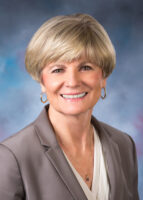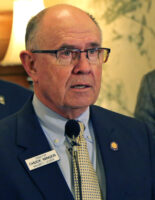A phaseout of Idaho’s “career ladder” to boost teacher salaries.
No more money earmarked for teacher training, a $21.5 million program.
No more earmarks for college and career advisers and mentors, a $9 million program.
Extra dollars for English language learners, special education students and gifted and talented students.
Nothing is final. These are a few concepts among many — a long list of ideas to run through computer models in the weeks and months to come. But on Wednesday, the concepts for a new school funding formula became a bit more clear. The recurring theme: Lawmakers want to look at streamlining the budget, getting rid of line items such as the career ladder, and give school districts and charter schools money based on the number of students enrolled.
A legislative committee reconvened at the Statehouse and took the first steps toward a funding formula rewrite. Lawmakers didn’t make any formal recommendations, and won’t until the fall.
Still, Wednesday’s meeting represented a turning point of sorts. Since 2016, the Public School Funding Formula Committee has been studying the formula — Idaho’s complex and controversial instrument to carve up $1.8 billion in K-12 dollars. The committee plans to have recommendations for the 2019 Legislature.
One of the touchiest recommendations could center on teacher pay — which stands to reason, since salaries and benefits account for about 85 percent of K-12 spending.
For 2018-19, the state earmarked $761.6 million for teacher salaries under the career ladder. It’s the largest of the myriad line items that lawmakers have shoehorned into the school funding formula.
Theoretically, the Legislature could leave the career ladder intact. But the Education Commission of the States — the committee’s Denver-based and taxpayer-funded consultants — recommend plowing the $761.6 million into the new funding formula. And lawmakers agreed to look at the idea, or at least run it through the computer models.
Even if the career ladder goes away, that doesn’t mean salaries will shrink. School leaders would still be able to decide how much money to put into their local pay pool.
In this case, spending flexibility is a two-edged sword. It can allow local administrators to free up money and keep veteran teachers in the classroom. On the other hand, said ECS senior consultant Michael Griffith, administrators might feel pressured to put so much money into salaries that other needs go wanting.
Adopted in 2015, the career ladder is a five-year plan to boost teacher salaries by about $250 million. And the career ladder was a recurring theme in Wednesday’s 4 1/2-hour meeting.
State Board of Education President Linda Clark, a funding formula committee member, praised lawmakers for putting money into a plan that will boost beginning teacher pay by 29 percent. But the former West Ada school superintendent said the state still faces an ongoing issue. It is challenging to retain veteran teachers, even in the Treasure Valley, as many teachers move from rural and suburban districts for the “golden ticket” of a job in Boise.

Sen. Janie Ward-Engelking, D-Boise, blamed the structure of the career ladder. The retired teacher reminded lawmakers that they eschewed a key recommendation from Gov. Butch Otter’s K-12 task force: boosting high-end teacher salaries to $60,000.
And while the committee agreed to look at a post-career ladder funding formula, Sen. Chuck Winder said the plan has built some good will between teachers and legislators.
“I don’t want to see us lose all that good will,” said Winder, R-Boise, the committee’s Senate co-chair.

While lawmakers are willing to look at a simpler, streamlined K-12 funding map, many educators appear more than ready to trade in their 1994 funding model.
Citing a survey of nearly 700 Idahoans, and recapping input from a statewide series of public hearings and closed-door focus group sessions, ECS staffers said the message from the field is loud and clear.
“We didn’t need to spend a lot of time talking about how your system’s broken, because people recognize that,” Griffith told lawmakers.
Among the survey numbers: 95 percent of respondents said the current funding formula does not work well, while 75 percent said the formula does not provide local schools with adequate spending flexibility. Overwhelming majorities urged the state to earmark extra funding for students from low-income households, special education students, ELL students and gifted and talented students.
But it isn’t always easy to build concepts into a funding formula. Local administrators can find ways to manipulate the system and get a bigger share of money earmarked for gifted and talented programs or tiny rural schools, Griffith said.
As the committee heads into its third and final summer of work, the state’s education community is watching closely.
Among those in the audience Wednesday were lobbyists for the Idaho School Boards Association, the Idaho Association of School Administrators, the Idaho Education Association and Idaho Business for Education; Boise district Superintendent Don Coberly, West Ada district Superintendent Mary Ann Ranells; and Kuna district Superintendent Wendy Johnson. Also attending was Cindy Wilson, the Democratic nominee for state superintendent; Republican incumbent Sherri Ybarra was in attendance, as a committee member.
Ultimately, it will be up to the committee — 10 lawmakers, Clark and Ybarra — to recommend formula changes. Reminding the committee of its role, Griffith likened the paid consultants to golf caddies.
“If you want to tee off with a putter, it’s your choice to tee off with a putter,” he said.
